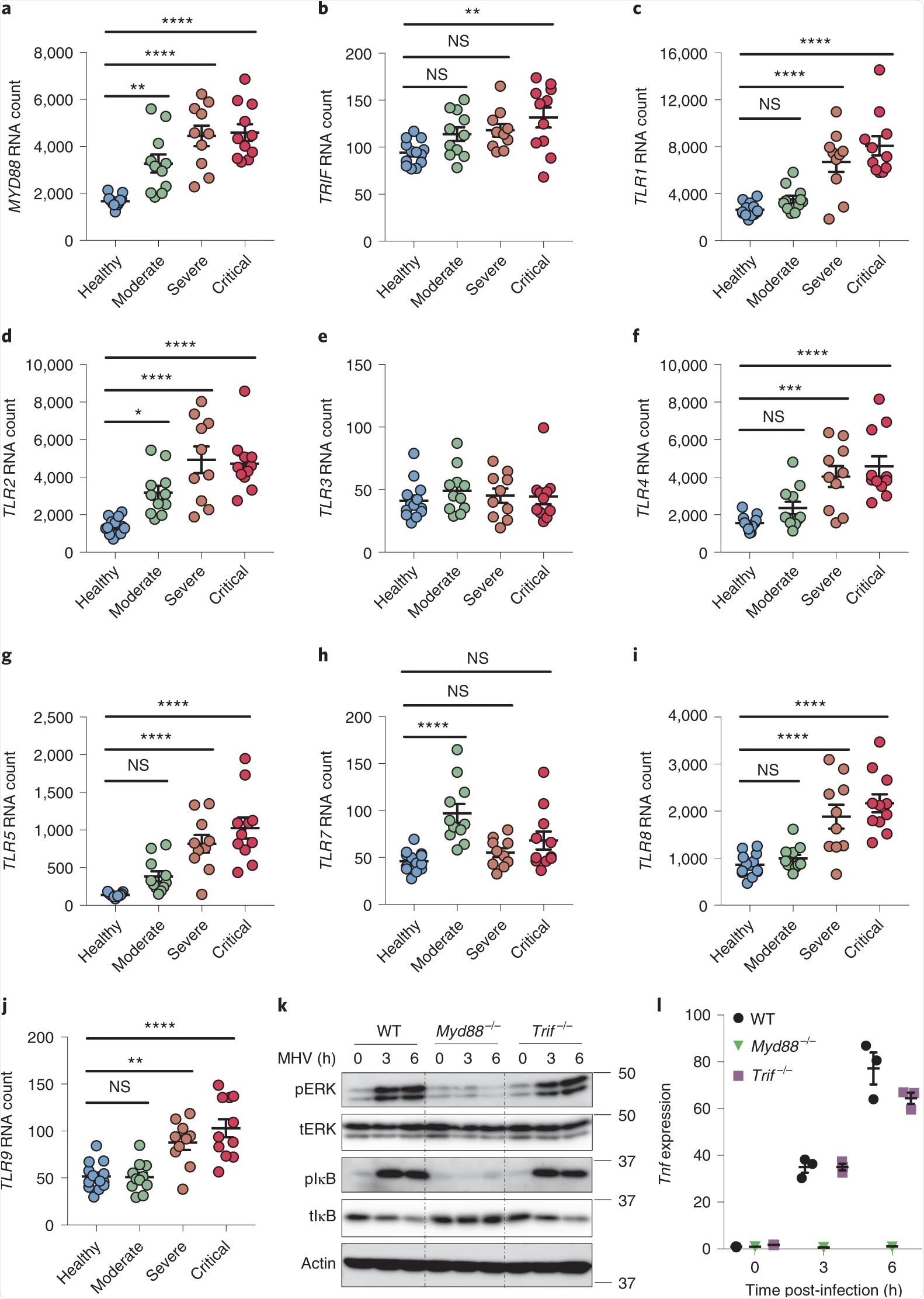Amid the coronavirus disease (COVID-19) pandemic, caused by the severe acute respiratory syndrome coronavirus 2 (SARS-CoV-2), scientists are racing to determine how the virus attacks the body and triggers a cytokine storm, causing severe illness in some patients.
Researchers at the Department of Immunology, St Jude Children’s Research Hospital in the United States found that toll-like receptor 2 (TLR2), a protein that is encoded by the TLR2 gene and plays a role in the immune system, detects the SARS-CoV-2 envelope protein-producing inflammatory cytokines.
In the study, published in the journal Nature, the team showed that both TLR2 and myeloid differentiation factor 88 (MyD88) expression were linked to COVID-19 disease severity. These two proteins are needed for beta-coronavirus-induced inflammatory responses.

Myd88 and TLRs are associated with the severity of COVID-19. Image Credit: https://www.nature.com/articles/s41590-021-00937-x/figures/1
Innate immune response
The innate immune response is crucial for recognizing and regulating infections through the release of cytokines and chemokines.
Cytokines are a wide range of signaling proteins generated after cellular activation, mediating and regulating immunity inflammation and hematopoiesis.
Meanwhile, chemokines are a large family of small, secreted proteins that signal through cell surface G protein-coupled heptahelical chemokine receptors. They stimulate the migration of cells, including white blood cells, during an infection.
The beta-coronavirus infection leads to a strong proinflammatory cytokine release, including tumor necrosis factor (TNF), interleukin (IL)-6, IL-1β, and interferon (IFN)-γ3–6. Though these cytokines are important elements in the innate immune response and help ward off viral infections, the uncontrolled release of proinflammatory cytokines can lead to a cytokine storm.
A cytokine storm, also called hypercytokemea, is the severe immune response in which the body releases too many cytokines into the blood quickly. Cytokines play a pivotal role in normal immune responses, but having large amounts released at once can be harmful.
The phenomenon can occur as a result of an infection, autoimmune condition, or other illnesses.
Patients with COVID-19 are at risk of developing a cytokine storm. This could destroy the human lungs and promote blood clotting. As a result, the blood clots can clog blood vessels in the heart and other organs, depriving them of oxygen and nutrients that can lead to multi-organ failure.
The cytokine storm’s effect on the development of COVID-19 has been extensively discussed since the virus first appeared. The increase in blood pro-inflammatory cytokines has been associated with disease pathogenesis and mortality.
Hence, many clinical trials are being conducted to block various cytokines and prevent severe COVID-19 illness, including IL-6 and TNF-α. However, blocking IL-6 has shown limited success. Recent studies have shown that TNF-α and IFN-γ are two important cytokines to target to prevent infection and disease progression.
The study
In the current study, the researchers noted that TLR2 sensed the SARS-CoV-2 envelope protein as its ligand, a molecule that produces a signal by binding to a target protein.
To arrive at the study findings, the team screened many innate sensors upstream of Myd88 to detect the required receptors to produce proinflammatory cytokines after betacoronavirus infection.
The team also aimed to gain a better understanding of how these cytokines are produced and their roles in COVID-19 infection.
The team also found that blocking TLR2 signaling in vivo protected against SARS-CoV-2 infection. The study findings revealed the important role of TLR2 in the pathogenesis of COVID-19. From there, scientists can identify possible strategies for therapeutics and drug development to curb the current global health crisis.
Overall, our study identified the key inflammatory signaling pathways activated during beta-coronavirus infection, which greatly improves our understanding of the molecular mechanism of beta-coronavirus-induced cytokine production,”
“These findings provide critical insights into strategies that can be pursued to control the development of the ongoing COVID-19 pandemic,” they added.
Currently, the pandemic continues to wreak havoc across the globe. To date, there are over 163.18 million cases and 3.38 million deaths tied to COVID-19.
The United States remains as the nation with the highest number of cases, reaching 32.95 million cases, followed by India and Brazil, with 24.96 million cases and 15.62 million cases, respectively.